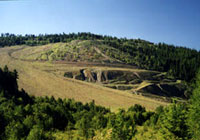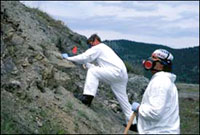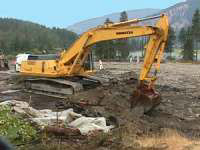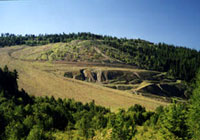It’s never been easy to make a living in Libby, Mont. Citizens in this town of 12,000, tucked into the dense, damp conifer forests of northwestern Montana, have long scraped by on seasonal logging jobs and other sporadic work. So in the 1920s, when local entrepreneur Edward Alley discovered that a nearby vermiculite deposit yielded an efficient, lightweight insulation and fireproofing material, Libbyites were thrilled.

Mine site in Libby, Mont.
Photo: CDC.
For decades, the mine — dubbed Zonolite, like the brand-name insulation it produced — offered the best jobs in town. Townspeople bragged that their local product had “a hundred and one uses”; they put it in their garden soil and their Little League ball fields, and said it could even be used to make mold-resistant whole-wheat bread. When the Zonolite mine was sold to the multinational company W.R. Grace in 1963, not much changed for the Libby workers. Vermiculite mining and processing was hard work, and terribly dusty, but the mine jobs continued to pay better, and last longer, than anything else around.
In the 1970s, some current and former mine workers started to notice some shortness of breath; gradually, they became tethered to oxygen tanks and bound to their homes. Some developed rare, excruciating cancers. Worse, their wives, kids, and even some Libby residents with no connection to the mine started to develop similar symptoms. Only a few doctors recognized the lesions on their patients’ lungs for what they were: the signature symptom of asbestosis. It took dozens of painful deaths for Libby residents to admit that “their” company, W.R. Grace, had knowingly allowed its mine workers, its mine managers, and their families and neighbors to be poisoned with tremolite, a particularly nasty form of asbestos contained in Libby’s vermiculite deposit. [Clarification: In total, more than 190 people have died due to Grace’s mining operations in Libby, and hundreds more have contracted terminal illnesses.]

Sampling soil for the next asbestos thing near Libby.
Photo: USGS.
Though medical researchers had discovered the dangers of asbestos back in the 1930s, company officials spent decades hiding the extent of asbestos contamination at the mine. They dodged inspections, released data that downplayed asbestos-fiber counts, and refused to share employees’ medical information with regulators.
Even after many residents had acknowledged the cover-up and its consequences, it remained a local, little-known problem, and its victims began to quietly settle out of court. In late 1999, however, a journalist from the Seattle Post-Intelligencer broke the story that local newspapers had sat on for well over a decade. Within a week, the U.S. EPA had swooped in to investigate and Libby found itself and its long-silenced tragedy on the national stage.
State of Disgrace

Libby, Montana
By Andrea Peacock
Johnson Books, 244 pages, 2003
Journalist Andrea Peacock, who first covered the Libby disaster for Mother Jones, digs deep into the dust in her new book Libby, Montana: Asbestos and the Deadly Silence of an American Corporation. She unearths the long and often dark history of W.R. Grace, which was founded in Peru in the 1850s by two Irish brothers and later became notorious for its cozy relationships with former Nazis. The company’s shady dealings continued into the 1980s, when Grace executive J. Peter Grace — then the head of President Reagan’s Grace Commission, charged with paring down the federal bureaucracy — is thought to have squelched an EPA investigation into health problems associated with the vermiculite industry.
Peacock also chases down the far-reaching effects of Libby’s asbestos. Libby ore has been processed by nearly every state in the nation, and millions of buildings are still insulated with Zonolite. In 1970, Peacock writes, W.R. Grace skirted New York City regulations and supplied asbestos-contaminated vermiculite as fireproofing for the World Trade Center towers. After Sept. 11, 2001, the EPA measured dangerously high levels of asbestos in lower Manhattan’s air.
It’s a damning collection of evidence, and Peacock is clearly outraged by what she finds. Yet her tone is cool and level, that of an experienced and reliable journalist. Most of the drama in Libby, Montana is supplied by Peacock’s crowd of vivid characters. Her heroes include the straight-talking Gayla Benefield, who lost her parents to asbestosis and avenged their deaths in court; Les Skramstad, who worked at the mine for a little more than two years and now, four decades later, is dying from the asbestos he inhaled; and Paul Peronard, the head of the EPA’s Libby team, who, despite his citified shaved head and tattoos, has won over many conservative townspeople with his very un-bureaucratic candor. When Peacock asks him why the EPA didn’t intervene in the Libby situation before 1999, Peronard doesn’t mince words: “Um … because we’re a bunch of chickenshits?”

EPA cleanup efforts in Libby.
Photo: EPA.
One of the strengths of this book is that those who stayed quiet, or were slow to recognize the dangers, emerge as complex and even sympathetic figures. One of the company bosses, who helped cover up the asbestos problem at the mine, was an almost universally popular Libbyite. The local newspaper editor, who let his reporters bury the story for years, now regrets his inaction. Much of the real villainy in Libby, it seems, lay not with individuals but in the sum of their small, self-preserving silences. It’s a familiar tale: Since few understood the whole story, most saw no harm in hiding the little they knew.
Perhaps the most sobering passage in Peacock’s book is a vignette from Dillon, Mont., about 300 miles south of Libby. There, a small vermiculite mine — whose deposits are also tainted with tremolite — has proposed a dramatic expansion, and would have won state approval years ago had a local resident not heard about the Libby disaster. In 1999, Holly Miller started to organize opposition to the Dillon mine proposal and, with the help of public testimony by Gayla Benefield and Les Skramstad, managed to hold off the expansion. Still, she says, her town is divided on the issue to this day. “You’d think this would be the one time when people would stand up and say no. … But that’s not happening,” she says. “[They say] this is hurting our economy. … What does the economy have to do with this? I mean, we’re talking about people dropping over dead.”
The lesson of Libby, unfortunately, is one we’ve been forced to learn again and again: What we don’t know, or choose not to know, can very slowly kill us. Thanks to Peacock’s careful research and expert storytelling, that lesson will not easily be forgotten.



